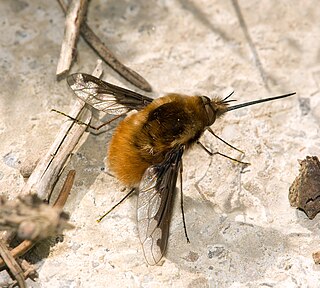
The Bombyliidae are a family of flies, commonly known as bee flies. Some are colloquially known as bomber flies. Adults generally feed on nectar and pollen, some being important pollinators. Larvae are mostly parasitoids of other insects.

Anthracinae is a subfamily of bee flies in the family Bombyliidae. There are more than 80 genera and 2,000 described species in Anthracinae.
Thyridanthrax luminis is a species of bee fly in the family Bombyliidae. It is known from California.

Thyridanthrax is a genus of bee flies in the family Bombyliidae. There are about 50 described species in the genus Thyridanthrax, found across Eurasia, Africa, North America, and South America.

Villini is a tribe of bee flies in the family Bombyliidae.
Conophorus nigripennis is a species of bee fly in the family Bombyliidae. It is found in the western United States from Arizona to Washington, and north to British Columbia, Canada.

Systoechus is a genus of bee flies in the family Bombyliidae. There are more than 120 described species in Systoechus.
Conophorus obesulus is a species of bee fly in the family Bombyliidae. It is found in the western United States from California to Colorado, and north to British Columbia, Canada.
Tmemophlebia coquilletti is a species of bee fly in the family Bombyliidae.
Lordotus junceus is a species of bee fly in the family Bombyliidae.
Diochanthrax is a genus of bee flies in the family Bombyliidae. There is one described species in Diochanthrax, D. morulus, found in California.
Toxophora virgata is a species of bee fly in the family Bombyliidae. It is found from Mexico through most of the western United States north to Canada. Hosts include potter wasps from the genera Odynerus and Stenodynerus.
Lordotus zona is a species of bee fly in the family Bombyliidae.
Chrysanthrax lepidotoides is a species of bee fly in the family Bombyliidae.

Chrysanthrax edititius is a species of bee fly in the family Bombyliidae.
Thyridanthrax andrewsi is a species of bee fly in the family Bombyliidae. It is found in the United States in California and Idaho.

Thyridanthrax fenestratoides is a species of bee fly in the family Bombyliidae. It is found in Canada from the Yukon to Ontario, south through most of the United States, and into Mexico. It is similar to the species T. fenestratus from Eurasia.
Thyridanthrax nugator is a species of bee fly in the family Bombyliidae. It is known from California and Oregon.

Thyridanthrax fenestratus is a Palearctic species of bee fly in the family Bombyliidae. It is found throughout Europe, through Greece and Turkey, Azerbaijan, Tajikistan and across the Palearctic to China in the East The larvae are parasitoids of Pemphredon fabricii pupae.
Thyridanthrax atratus is a species of bee fly in the family Bombyliidae.






